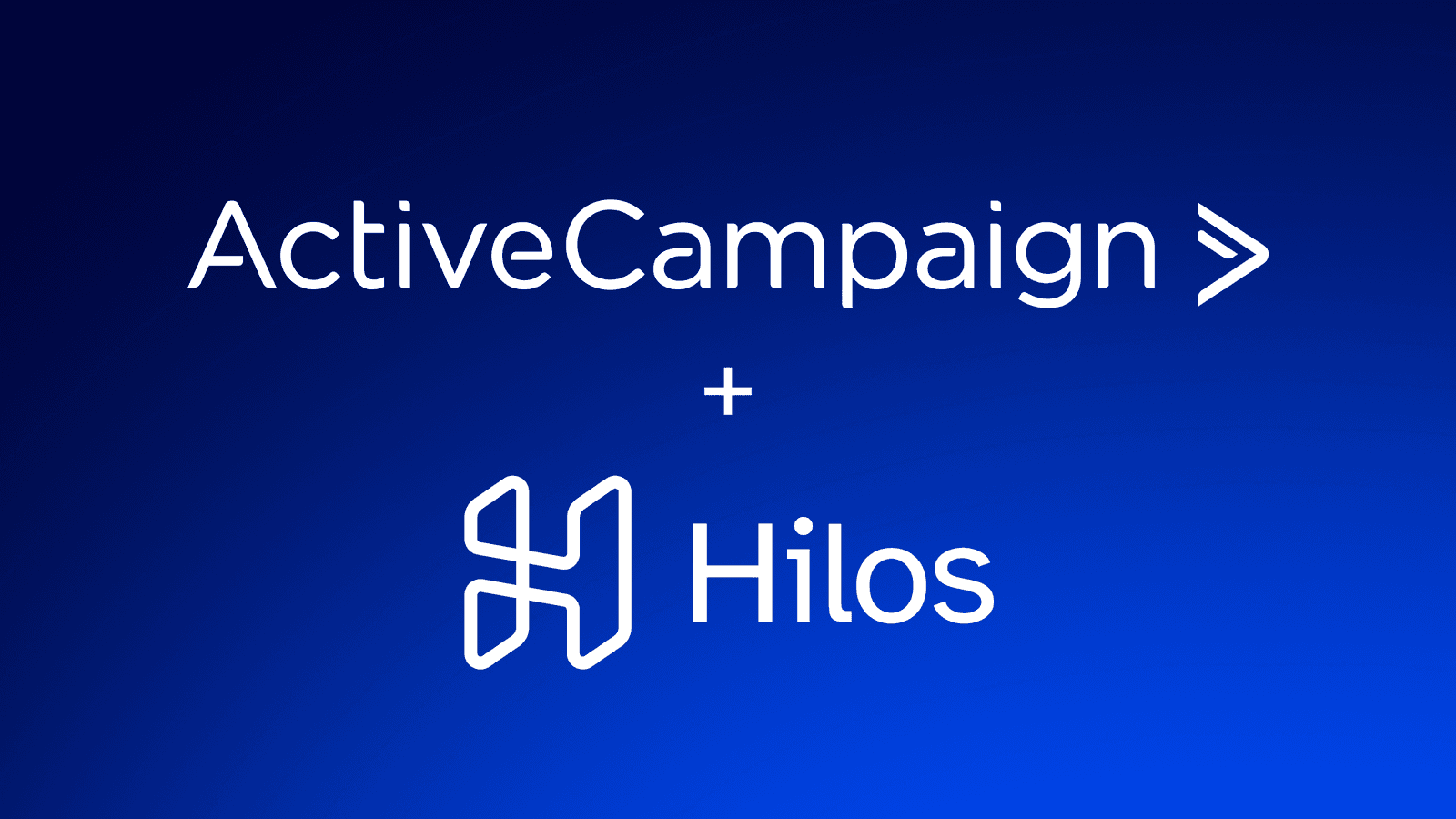The digital space is noisy.
Every day, over 347 billion emails are sent across the globe, inundating inboxes with a wave of messages vying for attention. Out of that number, 124 billion of them are coming from B2B and B2C email marketing strategies. With this overwhelming amount of communication, the ability to process and engage with each message is diminishing day by day.
It’s no secret that the customer’s attention is a finite and precious resource, making it increasingly challenging for businesses to capture and maintain the focus of their audience. Email blasts need to be precise and full of value.
With so much communication, the idea of re-engaging your customer base becomes an important undertaking for businesses to tackle and do well. It’s paramount to the success of your business and affects your bottom line. Email campaigns can be effective, but they only work if they can keep people interested. Sometimes, people stop paying attention to emails or even stop opening them. That's where crafting a reactivation email comes into play.
What is a reactivation email?
A reactivation email (also called a win-back email) is a targeted message sent by businesses or organizations to existing customers who have shown decreased engagement or inactivity over a certain period of time. The purpose of a reactivation email (and the overarching reactivation campaign) is to rekindle the recipient's interest and encourage them to reconnect with the brand, service, or platform. These emails often contain personalized content and sometimes include incentives such as special offers or discounts to entice recipients to re-engage. Reactivation emails aim to revive customer interest, foster renewed interaction, and potentially regain their loyalty and participation.
82% of people miss important emails because there is too much in their inboxes and 67% feel overwhelmed by the amount of emails they receive.
Although there is a lot of noise, it’s still possible to craft an effective and engaging reactivation email and turn your lapsed customers back into active ones. There are a few factors that come into play: proper timing, successfully segmenting your audience, and deciding what messaging is right for the best chance of re-engagement.
When should you send a reactivation email?
Determining the appropriate time to send a reactivation email to your customers is a strategic balancing act. The timing should be considerate of the customer's previous engagement patterns while also aligning with the goals of the re-engagement campaign. Ideally, a re-engagement email is sent when a customer's interaction frequency starts to decline, but before they become completely disengaged. For instance, if a customer hasn't opened or clicked on emails for a few months, it could be an opportune time to trigger a reactivation email.
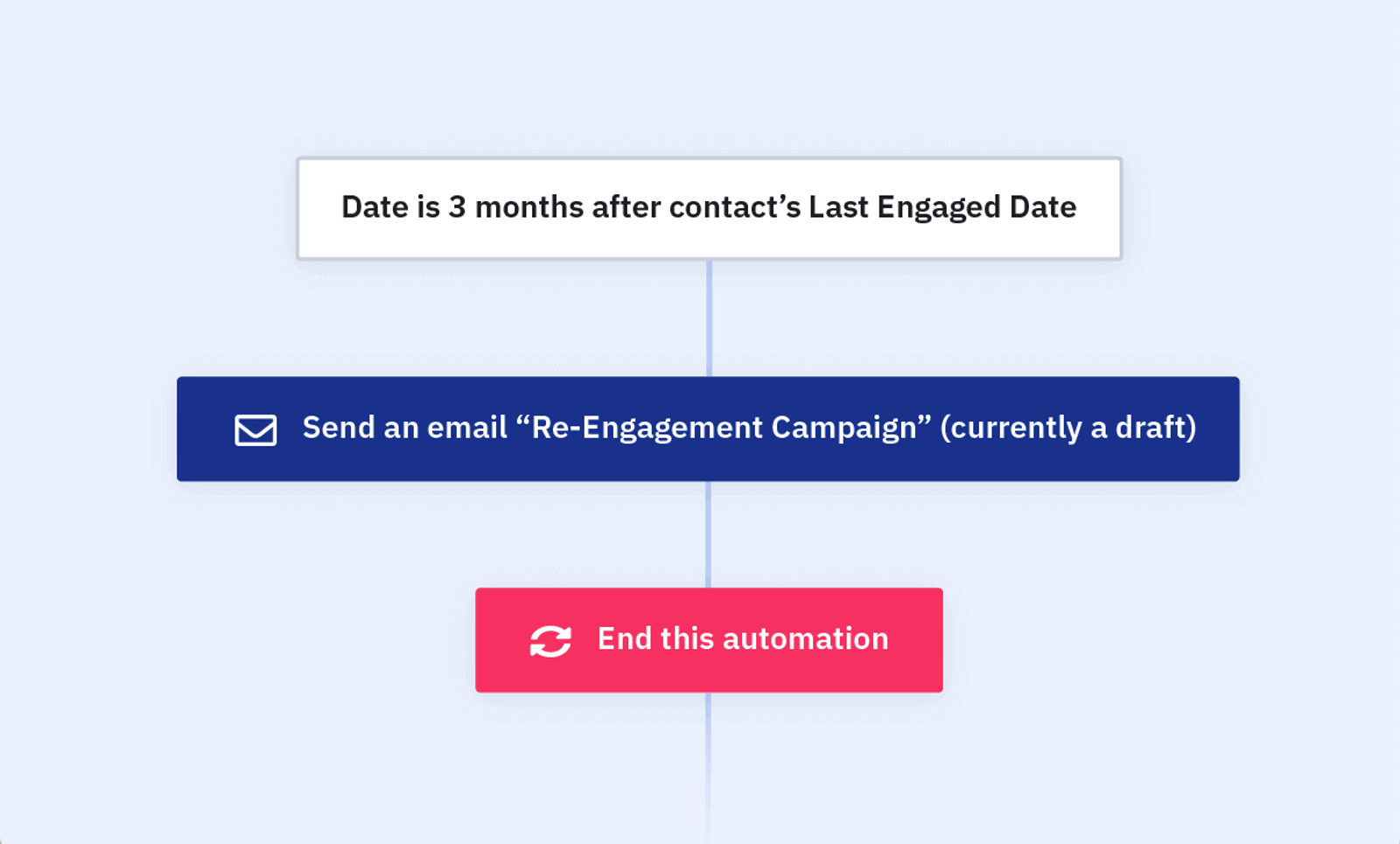
Moreover, the timing can be influenced by the nature of the business and the product or service being offered. For subscription-based services, sending reactivation emails a few days before a subscription renewal date could serve as a timely reminder. As for retailers, a reactivation email might be effective during seasonal promotions or special events to capture the customer's attention. Striking the right timing balance involves analyzing customer behavior, understanding their engagement patterns, and employing data-driven insights to pinpoint when recipients are most likely to respond positively to a reactivation effort.
Identify your active and passive subscribers
Before you start crafting your reactivation email, you'll need to identify the active and inactive subscribers in your email list. This will be based on different things like email opens, clicks to your website, recent purchases, and customers proactively signing up to be included in your email communications. You'll also need to determine the length of inactivity that officially labels a customer as inactive. This will be different for every business and depend on the company's typical customer profile, but typically, a customer who hasn’t engaged in over six months can be considered a lapsing customer.
Note: Customers who have been inactive for longer stretches of time like 9+ months should either be removed or added to a segment of customers that will need extra nurturing to get them back into the funnel.
Every company focused on email marketing will have a different software they use to keep track of and nurture their prospects and customers. In ActiveCampaign, you can see that contacts on your lists have one of four statuses: Active, Unconfirmed, Unsubscribed, or Bounced.

Something to keep in mind: In ActiveCampaign, contacts tagged as active are not necessarily engaged contacts who open emails and click on links. Active indicates that they've confirmed their subscription to your list and have not yet unsubscribed or bounced.
Based on where your customers fall under these filters, you can create a segment of contacts you'd like to re-engage with by sending them a reactivation email.
How to craft an engaging reactivation email
Crafting an effective reactivation email requires a thoughtful approach that strikes a chord with recipients and compels them to re-engage with your brand. To begin, the email subject line plays a pivotal role as the gateway to capturing attention. It should be concise yet intriguing, offering a glimpse of what awaits within the email. A touch of personalization, such as addressing the recipient by name, can add a sense of familiarity that resonates positively.
Read more: Wondering how to craft the best hook to pique customers' interest? We've laid it out for you in this article about writing an effective win-back email subject line.
Include content that is valuable
Moving beyond the subject line, the email content itself should be compelling and relevant. Address the recipient's previous interaction or history with the brand, reminding them of the value they once found. Highlight any new offerings, updates, or benefits they might have missed during their period of inactivity. Employ persuasive language that emphasizes the benefits of reengaging, whether it's exclusive discounts, access to new features, or relevant content that aligns with their interests.

This ActiveCampaign email is engaging and sharp. With a snappy hook "Ideate. Compose. Reiterate to perfection.", the recipient is intrigued. The body text highlights benefits that users will see when using ActiveCampaign's AI content generator, further proving value.
And who can forget the grand finale? Incorporating a clear call-to-action (CTA) is essential for guiding recipients toward the desired action you ultimately want them to take.
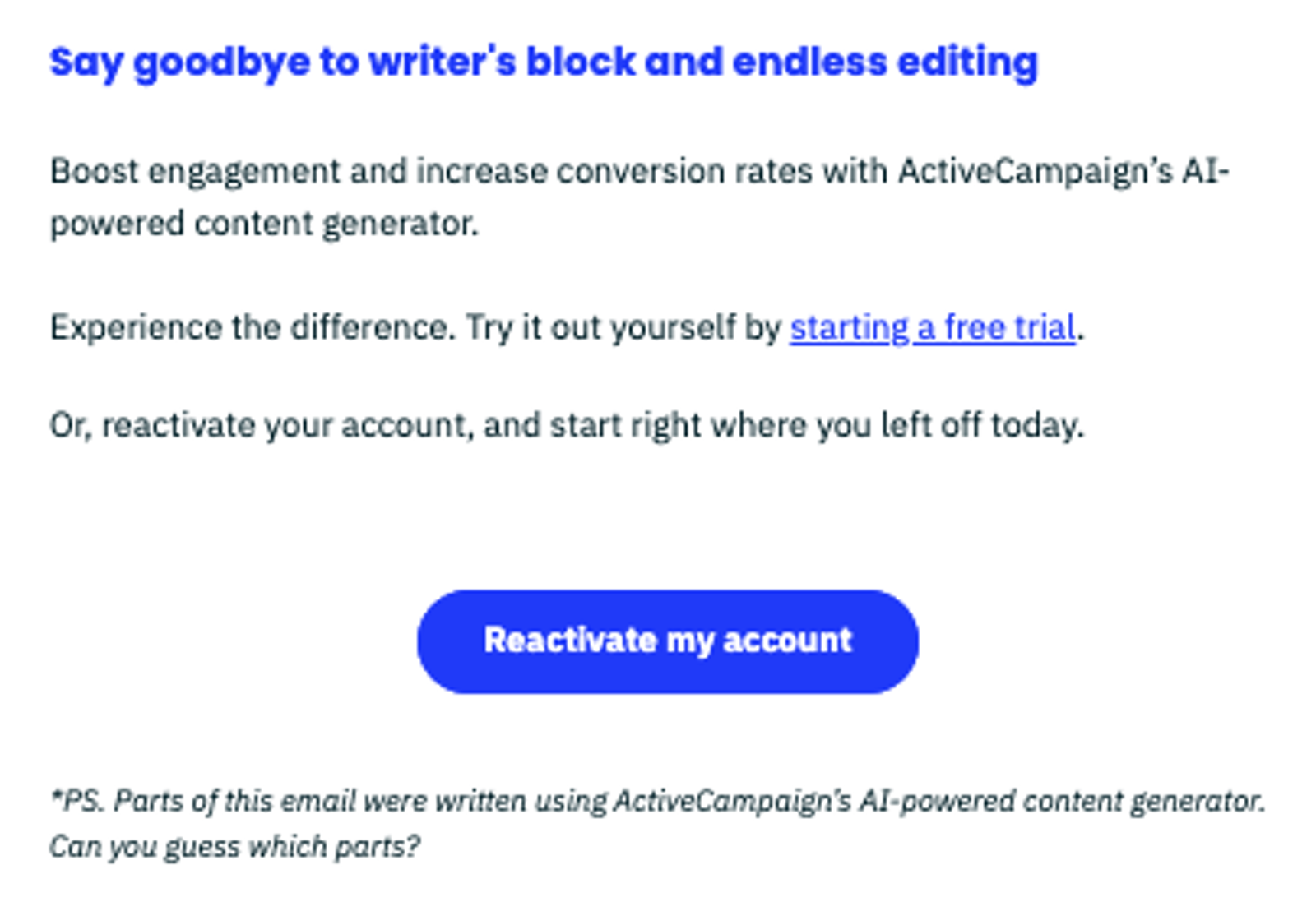
Whether it's clicking to explore new products, revisiting their abandoned cart, or simply updating their preferences, a well-defined CTA provides a direct path to re-engagement. In addition, the email design should be visually appealing and mobile-responsive, ensuring a seamless experience across various devices. By carefully crafting subject lines, an attention-grabbing email preheader, engaging content, and impactful CTAs, you'll be on your way to creating a reactivation email campaign that not only rekindles interest but also fosters renewed connections with your customers.
There are many kinds of emails. Learn how to format an email and a handful of different formats here.
Segment your lists
Segmenting your email list ensures your reactivation email campaign hits the bullseye with precision. It involves grouping your recipients based on shared traits, behaviors, or preferences, enabling you to sculpt your reactivation message to resonate with each segmentation of your email list. Segmenting helps to point your reactivation efforts in the right direction and to the right audience, minimizing email irrelevance and boosting your click-through rate.
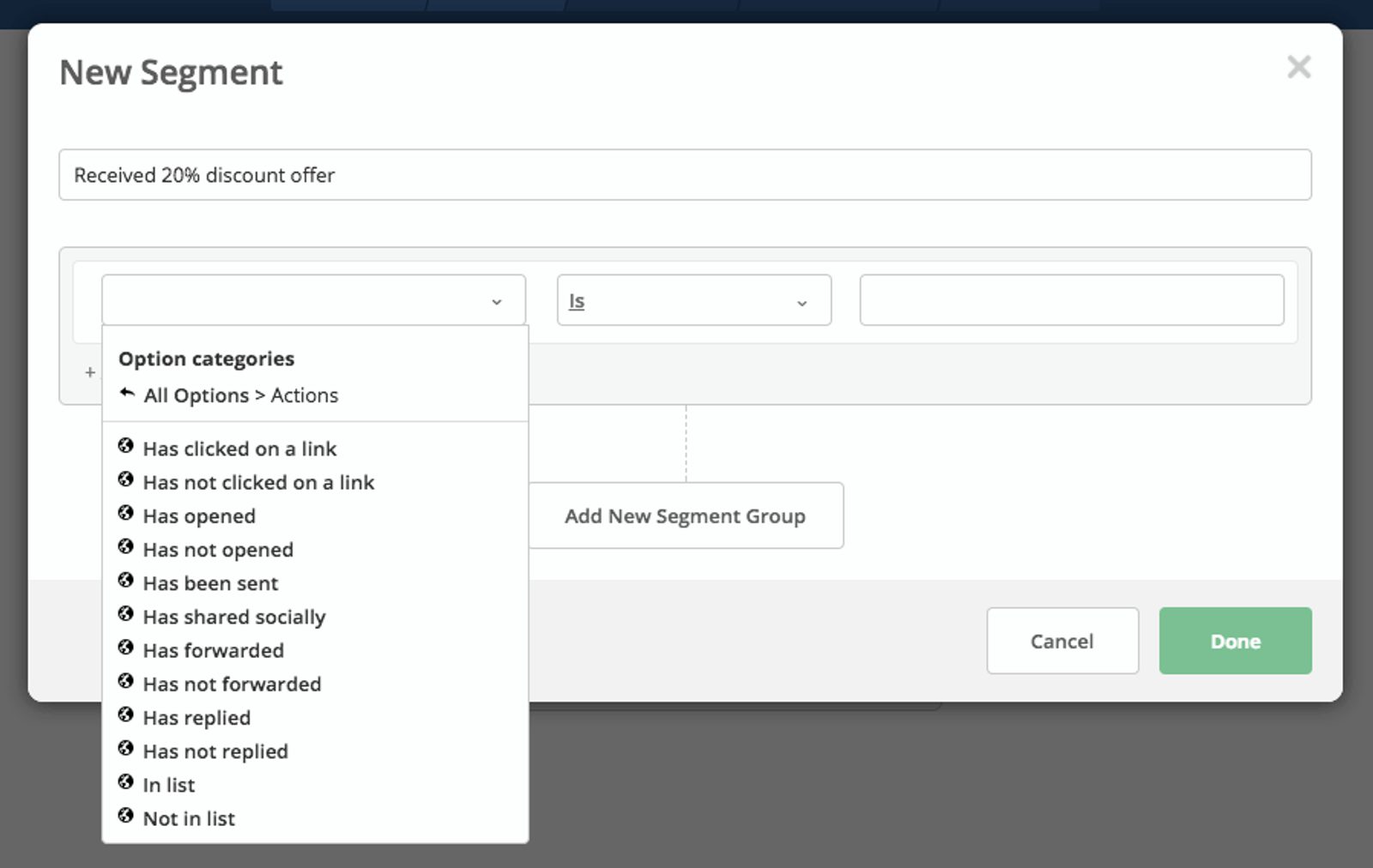
Segmentation allows you to target the perfect recipients for your reactivation campaign. For example, if you're trying to reignite interest among customers who once made purchases but have gone quiet, segmenting your list can help you pinpoint this group, tailor a compelling message that reminds them of their past interactions, and bring them back as active subscribers. Plus, by sorting based on engagement history, you can avoid sending reactivation emails to those who are already active, saving resources and preserving a positive user experience.
Remember: You should never send a reactivation email to your entire email list. Segmenting your contacts to target the right recipients is crucial so you’re not bothering engaged customers who don’t need to be reactivated.
Know your audience
Once you've segmented your audience and defined who you'll be sending your reactivation email campaign to, you'll want to dig into your customer's data and preferences. This enables you to tailor your approach and resonate on a personal level. By sorting your email list based on various factors such as purchase history, customer lifetime value, engagement levels, and demographics, you can unlock a treasure trove of insights that lay the foundation for crafting customer-specific, relatable, and engaging emails.
Analyzing purchase history
Analyzing purchase history allows you to pinpoint what products or services your customers have shown interest in or bought previously. This knowledge serves as a launchpad to recommend similar items or highlight updates within their areas of interest.
Research customer lifetime value
Evaluating customer lifetime value provides a strategic lens into the long-term potential of re-engagement efforts. Customers who have consistently demonstrated loyalty and higher spending may warrant a more tailored and enticing reactivation approach, potentially including exclusive offers or advanced previews of upcoming offerings. If one of your most engaged customers happens to fall off, it may be worth it to craft and send them a fully personalized email to check in with them.
Turning an inactive subscriber into a customer is 5x cheaper than acquiring a completely new customer, where inactive subscribers generate 7% of overall business revenue.
Understand their engagement level
Looking back on engagement levels helps you understand how frequently and actively customers have interacted with your brand. This segmentation allows you to tailor the reactivation email's tone, content, and incentives based on their level of familiarity. Demographic insights, such as location or age group, add another layer of personalization, ensuring that the email's message resonates within its unique context. By leveraging these insights, you can create reactivation emails that aren't just generic, rather they'll cultivate a genuine connection that reignites the customer's interest and guides them towards meaningful re-engagement.
Personalize it
Now that you understand who your target audience is, it’s time to personalize. When it comes to email marketing, personalization is everything. In order to craft a truly impactful reactivation email, you'll see the best results when you use things like personalization tags within the subject line and body copy of your email.
Recent data shows that personalized emails have a 29% higher open rate and a 41% higher click-through rate than non-personalized emails.
Using the recipient's name, past purchases, interests, and preferences, you'll have a much higher chance of making the email feel more personal and relevant to each customer. Going a step further, you can enlist the help of dynamic content, a feature that allows you to customize emails based on the recipient's behavior, interests, or location. This further boosts the chance of reengaging them.
A/B test it
As you begin to deploy your reactivation campaign, it's crucial to test different emails and track their performance. A/B testing allows businesses to fine-tune their approach with incredible precision. For example, A/B testing different subject lines helps unveil which phrasing, tone, or sense of urgency piques recipients' curiosity, driving them to open the email.

Similarly, testing variations in automated email copy and content can shed light on what language or message aligns best with your target audience, fostering higher click-through rates and engagement. When it comes to incentives, A/B testing can unveil the allure of different discount percentages or special offers, revealing which enticements wield the most persuasive power in luring recipients back into the fold.
A/B testing like this gives you valuable insights into what resonates most effectively, enabling you to optimize your reactivation strategy as you go.
5 impressive reactivation email examples
Now that we've covered the best practices for crafting a reactivation email, we can take a look at five different examples you can use as a jumping-off point for inspiration.
Grammarly
This reactivation email works well because it incorporates humor and gives the recipient a reward for not using their product. Who would've thought? The subtle joke shows the recipient that Grammarly has a sense of humor and doesn't take itself too seriously. Because of this, they may feel endeared by the brand and reconsider using the writing tool.

Duolingo
This reactivation email from Duolingo is great because of its use of emotion. The recipient is greeted by their crying owl mascot and prompted to take a five minute lesson to get back on track.

Shopify
This Shopify reactivation email is a super effective example of two re-engagement techniques: asking for feedback and offering an incentive. The email asks the recipient to give their honest feedback on their features, leaving room for them to voice how they really feel about Shopify. Plus, they create urgency by including the chance to win an $800 Apple voucher if they complete the survey by a specific date.
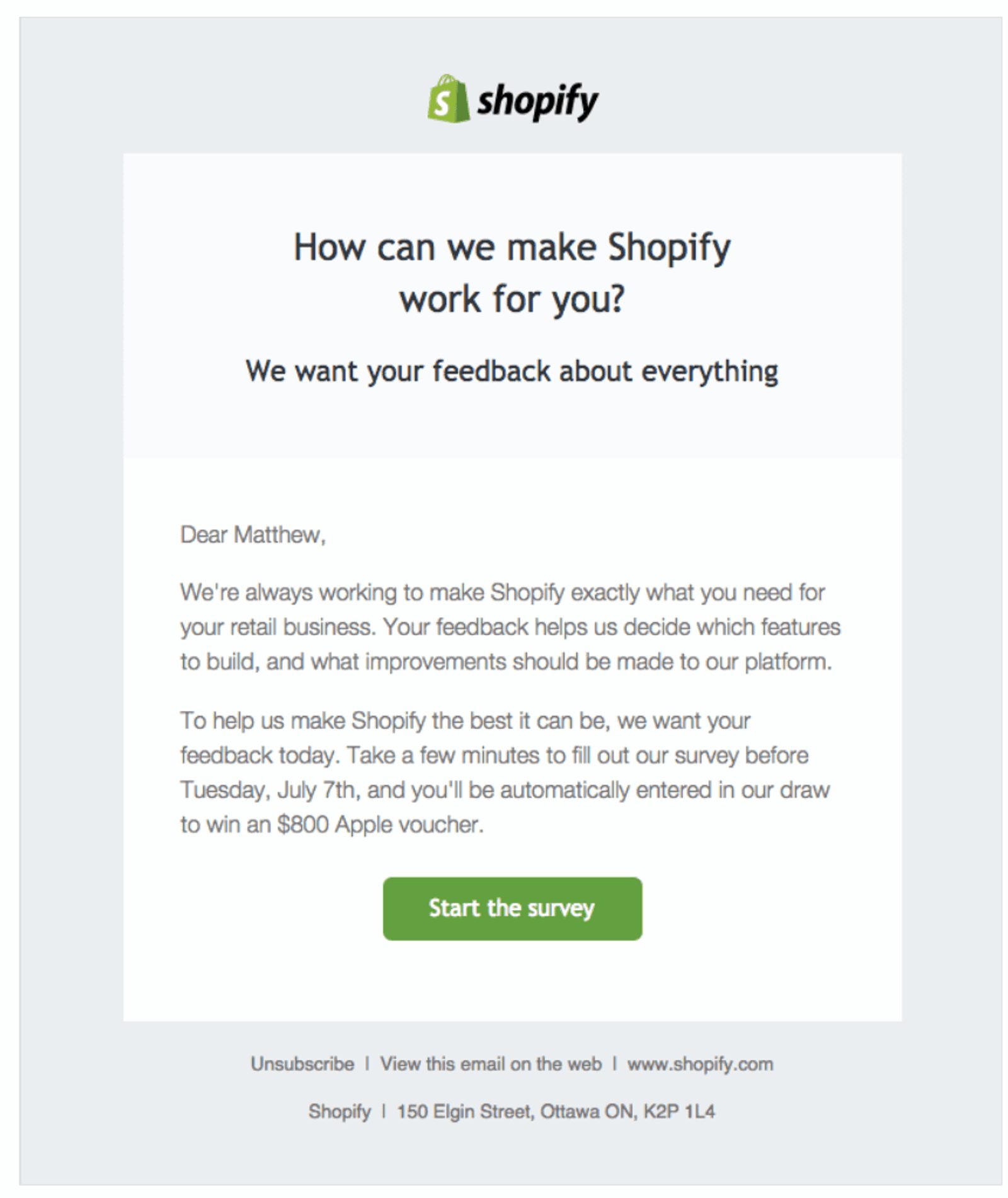
Asana
Asana sent out a great reactivation email that piqued recipients' interest by announcing updates to the product. These speed improvements are a great way to intrigue past customers, re-engage them, and get them back into the platform so they can take advantage of the increased productivity the tool is promising their team.
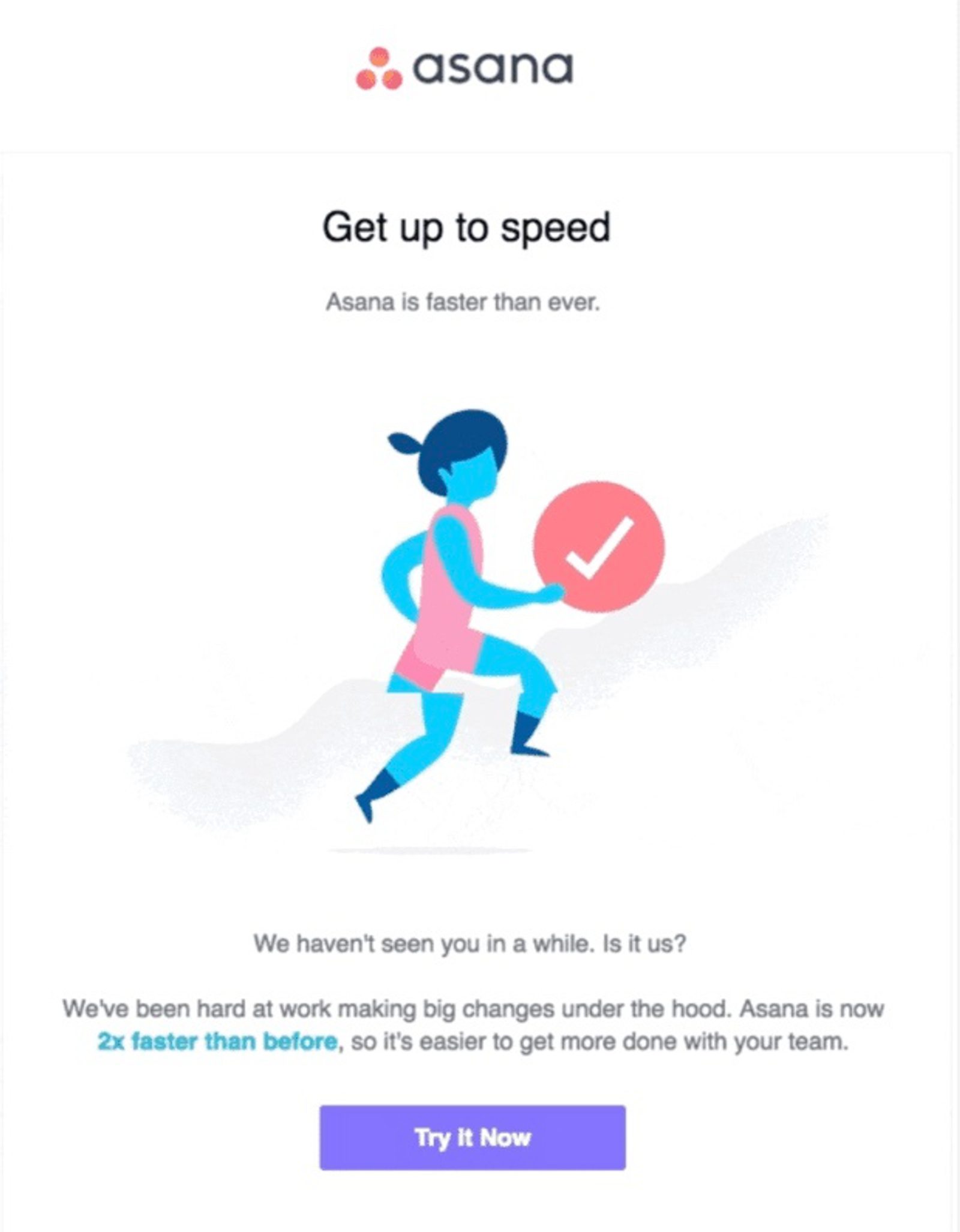
Sephora
This reactivation email from Sephora uses the incentive technique. Because the recipient hasn't been engaged with their email campaigns, Sephora is using a $15 gift card to entice them back to purchase more products. Plus, the gift card has an expiration date, encouraging the recipient to buy a product before they miss out on the offer.
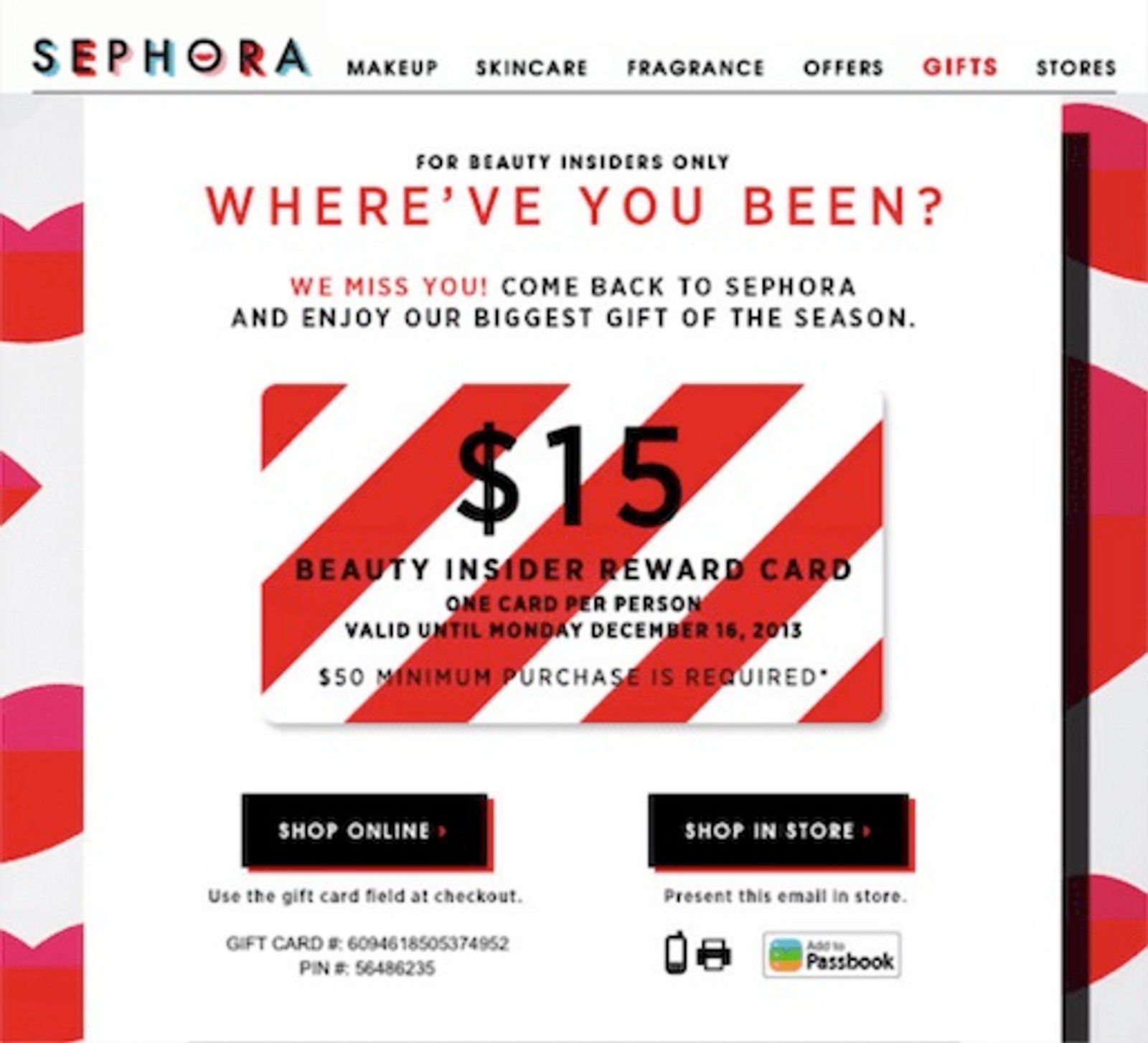
Benefits of a reactivation email campaign
When you begin crafting a reactivation email, and a larger reactivation campaign, it's no surprise that there are a handful of benefits you'll be able to see as each email is sent. These benefits can be game-changers in how your team approaches lapsed customers and can drive your strategy in a direction you may never have taken without the insights you glean from a re-engagement campaign.
Improves brand loyalty
When recipients receive personalized emails tailored to their interests and past interactions, it showcases a brand's genuine care and commitment to rekindling a connection. This thoughtful gesture resonates on a deeper level, evoking a sense of value and appreciation among your customers. By reaching out to customers who have lapsed, reactivation emails demonstrate a brand's dedication to maintaining the relationship, even in times of diminished engagement.
Deeper understanding of customer behavior
The results of a reactivation campaign give you an incredible understanding of customer behavior, providing a look at their engagement patterns and preferences. By tracking metrics such as open rates, click-through rates, and conversion rates, businesses can glean a nuanced understanding of how their customers respond to re-engagement efforts and create an email roadmap to ensure that future campaigns have the best chance at resonating.

The data derived from a reactivation campaign serves as a compass for refining your email list. Analyzing customer responses allows businesses to identify segments that displayed a willingness to re-engage, giving them a better idea of where to focus their efforts. On the other hand, it allows businesses to identify segments that aren't as willing, prompting thoughtful consideration on whether to continue targeting these groups or reassessing their inclusion in future campaigns.
Click here to learn how a follow-up email is different than a reactivation email and how to write one.
Get crafting
It's your turn to start thinking about how you'll approach disengaged customers and which techniques will give you the best chance at re-engaging them. Winning back inactive subscribers isn't easy by any means and there will always be a group of customers you'll probably never get back, but don't let that discourage you.
By using some of the inspiration from the emails we shared above and combining that with the best practices we covered at the beginning, you'll have the right tools and techniques to bring customers back and ultimately recapture that "lost" revenue.
Ready to get started? Try us out for free and sign up for a trial in the box to the right →



